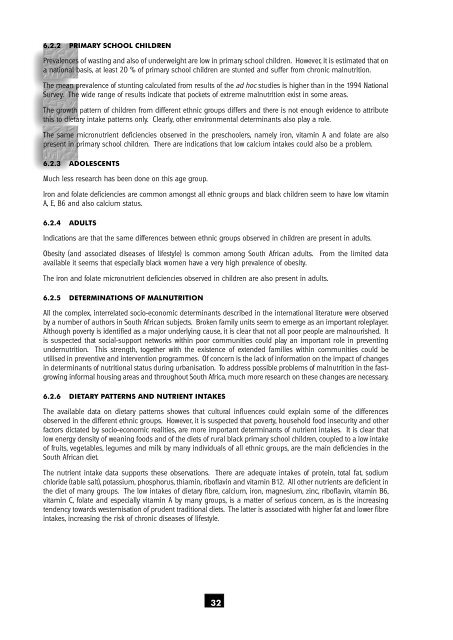the nutritional status of - Health Systems Trust
the nutritional status of - Health Systems Trust
the nutritional status of - Health Systems Trust
Create successful ePaper yourself
Turn your PDF publications into a flip-book with our unique Google optimized e-Paper software.
6.2.2 PRIMARY SCHOOL CHILDREN<br />
Prevalences <strong>of</strong> wasting and also <strong>of</strong> underweight are low in primary school children. However, it is estimated that on<br />
a national basis, at least 20 % <strong>of</strong> primary school children are stunted and suffer from chronic malnutrition.<br />
The mean prevalence <strong>of</strong> stunting calculated from results <strong>of</strong> <strong>the</strong> ad hoc studies is higher than in <strong>the</strong> 1994 National<br />
Survey. The wide range <strong>of</strong> results indicate that pockets <strong>of</strong> extreme malnutrition exist in some areas.<br />
The growth pattern <strong>of</strong> children from different ethnic groups differs and <strong>the</strong>re is not enough evidence to attribute<br />
this to dietary intake patterns only. Clearly, o<strong>the</strong>r environmental determinants also play a role.<br />
The same micronutrient deficiencies observed in <strong>the</strong> preschoolers, namely iron, vitamin A and folate are also<br />
present in primary school children. There are indications that low calcium intakes could also be a problem.<br />
6.2.3 ADOLESCENTS<br />
Much less research has been done on this age group.<br />
Iron and folate deficiencies are common amongst all ethnic groups and black children seem to have low vitamin<br />
A, E, B6 and also calcium <strong>status</strong>.<br />
6.2.4 ADULTS<br />
Indications are that <strong>the</strong> same differences between ethnic groups observed in children are present in adults.<br />
Obesity (and associated diseases <strong>of</strong> lifestyle) is common among South African adults. From <strong>the</strong> limited data<br />
available it seems that especially black women have a very high prevalence <strong>of</strong> obesity.<br />
The iron and folate micronutrient deficiencies observed in children are also present in adults.<br />
6.2.5 DETERMINATIONS OF MALNUTRITION<br />
All <strong>the</strong> complex, interrelated socio-economic determinants described in <strong>the</strong> international literature were observed<br />
by a number <strong>of</strong> authors in South African subjects. Broken family units seem to emerge as an important roleplayer.<br />
Although poverty is identified as a major underlying cause, it is clear that not all poor people are malnourished. It<br />
is suspected that social-support networks within poor communities could play an important role in preventing<br />
undernutrition. This strength, toge<strong>the</strong>r with <strong>the</strong> existence <strong>of</strong> extended families within communities could be<br />
utilised in preventive and intervention programmes. Of concern is <strong>the</strong> lack <strong>of</strong> information on <strong>the</strong> impact <strong>of</strong> changes<br />
in determinants <strong>of</strong> <strong>nutritional</strong> <strong>status</strong> during urbanisation. To address possible problems <strong>of</strong> malnutrition in <strong>the</strong> fastgrowing<br />
informal housing areas and throughout South Africa, much more research on <strong>the</strong>se changes are necessary.<br />
6.2.6 DIETARY PATTERNS AND NUTRIENT INTAKES<br />
The available data on dietary patterns showes that cultural influences could explain some <strong>of</strong> <strong>the</strong> differences<br />
observed in <strong>the</strong> different ethnic groups. However, it is suspected that poverty, household food insecurity and o<strong>the</strong>r<br />
factors dictated by socio-economic realities, are more important determinants <strong>of</strong> nutrient intakes. It is clear that<br />
low energy density <strong>of</strong> weaning foods and <strong>of</strong> <strong>the</strong> diets <strong>of</strong> rural black primary school children, coupled to a low intake<br />
<strong>of</strong> fruits, vegetables, legumes and milk by many individuals <strong>of</strong> all ethnic groups, are <strong>the</strong> main deficiencies in <strong>the</strong><br />
South African diet.<br />
The nutrient intake data supports <strong>the</strong>se observations. There are adequate intakes <strong>of</strong> protein, total fat, sodium<br />
chloride (table salt), potassium, phosphorus, thiamin, rib<strong>of</strong>lavin and vitamin B12. All o<strong>the</strong>r nutrients are deficient in<br />
<strong>the</strong> diet <strong>of</strong> many groups. The low intakes <strong>of</strong> dietary fibre, calcium, iron, magnesium, zinc, rib<strong>of</strong>lavin, vitamin B6,<br />
vitamin C, folate and especially vitamin A by many groups, is a matter <strong>of</strong> serious concern, as is <strong>the</strong> increasing<br />
tendency towards westernisation <strong>of</strong> prudent traditional diets. The latter is associated with higher fat and lower fibre<br />
intakes, increasing <strong>the</strong> risk <strong>of</strong> chronic diseases <strong>of</strong> lifestyle.<br />
32
















